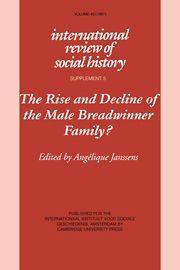 The Rise and Decline of the Male Breadwinner Family?
The Rise and Decline of the Male Breadwinner Family? Book contents
- Frontmatter
- Contents
- NOTES ON CONTRIBUTORS
- 1 The Rise and Decline of the Male Breadwinner Family? An Overview of the Debate
- 2 The Origins and Expansion of the Male Breadwinner Family: The Case of Nineteenth-Century Britain
- 3 Gendered Exclusion: Domesticity and Dependence in Bengal
- 4 Breadwinning Patterns and Family Exogenous Factors: Workers at the Tobacco Factory of Seville during the Industrialization Process, 1887–1945
- 5 Family, Work and Wages: The Stéphanois Region of France, 1840–1914
- 6 Welfare State Attitudes to the Male Breadwinning System: The United States and Sweden in Comparative Perspective
- 7 Comparing the Post-War Germanies: Breadwinner Ideology and Women's Employment in the Divided Nation, 1948–1970
- Notes On Contributors
6 - Welfare State Attitudes to the Male Breadwinning System: The United States and Sweden in Comparative Perspective
Published online by Cambridge University Press: 04 August 2010
- Frontmatter
- Contents
- NOTES ON CONTRIBUTORS
- 1 The Rise and Decline of the Male Breadwinner Family? An Overview of the Debate
- 2 The Origins and Expansion of the Male Breadwinner Family: The Case of Nineteenth-Century Britain
- 3 Gendered Exclusion: Domesticity and Dependence in Bengal
- 4 Breadwinning Patterns and Family Exogenous Factors: Workers at the Tobacco Factory of Seville during the Industrialization Process, 1887–1945
- 5 Family, Work and Wages: The Stéphanois Region of France, 1840–1914
- 6 Welfare State Attitudes to the Male Breadwinning System: The United States and Sweden in Comparative Perspective
- 7 Comparing the Post-War Germanies: Breadwinner Ideology and Women's Employment in the Divided Nation, 1948–1970
- Notes On Contributors
Summary
Human reproduction is a basic economic activity in every society. It includes activities such as maternal care, childcare, old age provision, poor relief, healthcare, and labour protection. In pre-industrial times, human reproduction was typically a part of kin-based household economies, but since the onset of industrialization two new institutional solutions have developed: the male breadwinning system and the welfare state.
In historical perspective, the male breadwinning system builds on earlier household-based reproductive practices. It constitutes a basically private approach, marked by a female specialization in reproductive activities. According to male breadwinning ideology, men are primarily providers, responsible only for professional and financial aspects of the reproductive process. Married women, by contrast, are supposed to perform most of the work needed to reproduce the population. This work is unpaid and consequently married women are economically dependent on their husbands.
In practice, of course, male breadwinning systems diverge more or less from the strict gender division of labour prescribed by male breadwinner ideology. In particular, married women have often participated in breadwinning activities. More importantly, however, there is no industrialized society in which the male breadwinning system has been capable of carrying out the national reproductive process without public support. Along varying institutional paths, public institutions have intervened to take on responsibility for smaller or larger parts of the national reproductive burden. Welfare states have taken shape.
Welfare states have differed markedly in their attitude to the male breadwinning system, and although all welfare states have modified their adherence to the male breadwinning model in recent decades, important distinctions remain.
- Type
- Chapter
- Information
- The Rise and Decline of the Male Breadwinner Family?Studies in Gendered Patterns of Labour Division and Household Organisation, pp. 153 - 174Publisher: Cambridge University PressPrint publication year: 1998
- 2
- Cited by
